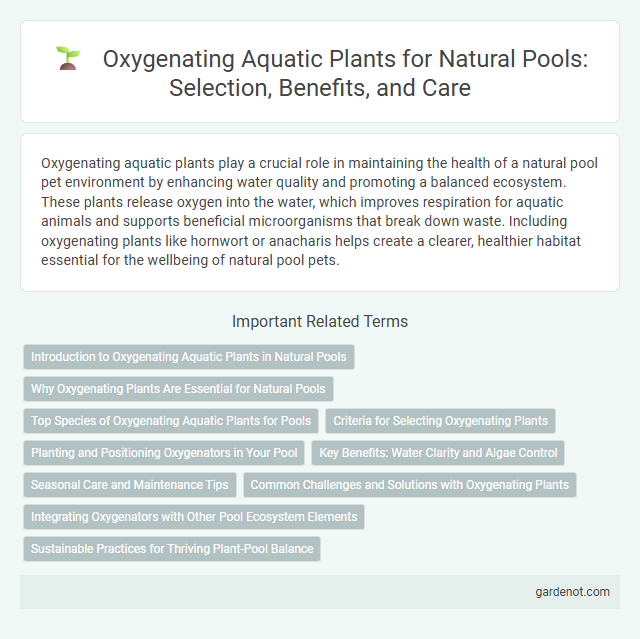Oxygenating aquatic plants play a crucial role in maintaining the health of a natural pool pet environment by enhancing water quality and promoting a balanced ecosystem. These plants release oxygen into the water, which improves respiration for aquatic animals and supports beneficial microorganisms that break down waste. Including oxygenating plants like hornwort or anacharis helps create a clearer, healthier habitat essential for the wellbeing of natural pool pets.
Introduction to Oxygenating Aquatic Plants in Natural Pools
Oxygenating aquatic plants play a crucial role in natural pools by enhancing water quality through photosynthesis, increasing dissolved oxygen levels essential for aquatic life. These plants help maintain a balanced ecosystem, suppress algae growth, and contribute to the natural filtration process by absorbing nutrients and pollutants. Common oxygenating plants include Elodea, Hornwort, and Water Milfoil, which thrive submerged and create a healthy habitat for beneficial microorganisms.
Why Oxygenating Plants Are Essential for Natural Pools
Oxygenating aquatic plants like hornwort, elodea, and anacharis play a crucial role in natural pools by enhancing water quality through efficient oxygen production and nutrient absorption. These plants reduce algae growth by competing for nutrients and create a balanced aquatic ecosystem that supports beneficial microorganisms and aquatic life. Their presence maintains clear, healthy water, improving the overall sustainability and aesthetic appeal of natural swimming pools.
Top Species of Oxygenating Aquatic Plants for Pools
Top species of oxygenating aquatic plants for natural pools include Hornwort (Ceratophyllum demersum), Anacharis (Elodea canadensis), and Water Milfoil (Myriophyllum spicatum), known for their efficient oxygen production and water purification abilities. These plants enhance pool ecosystems by increasing dissolved oxygen levels, reducing algae growth, and providing habitat for beneficial microorganisms. Incorporating a mix of submerged oxygenators supports balanced water chemistry and promotes a healthy, clear natural pool environment.
Criteria for Selecting Oxygenating Plants
Oxygenating aquatic plants selected for natural pools must exhibit strong photosynthetic capacity to enhance dissolved oxygen levels, support aquatic life, and improve water clarity. Ideal species demonstrate adaptability to variable water depths, rapid growth rates to maintain oxygen production, and resistance to pests and diseases to ensure long-term ecosystem stability. Selecting plants like Elodea canadensis or Ceratophyllum demersum provides efficient oxygenation, nutrient absorption, and habitat for beneficial microorganisms.
Planting and Positioning Oxygenators in Your Pool
Planting oxygenating aquatic plants in your natural pool involves situating species like Egeria densa or Hornwort in shallow areas with ample sunlight to maximize photosynthesis and oxygen production. Position oxygenators near water inlets or circulation points to enhance water movement around the plants, improving oxygen distribution throughout the pool. Regularly monitor plant density to prevent overcrowding while maintaining optimal oxygen levels for aquatic life balance.
Key Benefits: Water Clarity and Algae Control
Oxygenating aquatic plants enhance water clarity by increasing dissolved oxygen levels, which supports beneficial aerobic bacteria that break down organic matter and reduce nutrient buildup. These plants create a natural barrier against algae growth by competing for nutrients, thereby limiting the resources algae need to thrive. Incorporating oxygenating plants in a natural pool promotes a balanced ecosystem, resulting in clearer water and reduced algae proliferation.
Seasonal Care and Maintenance Tips
Oxygenating aquatic plants such as hornwort and elodea play a critical role in maintaining water quality in natural pools by increasing oxygen levels and reducing algae growth. Seasonal care involves trimming dead or decaying foliage in spring and fall to prevent nutrient buildup and promote healthy growth. Regularly monitoring plant health and removing excess vegetation during peak summer months ensures balanced oxygenation and enhances the overall ecosystem of the natural pool.
Common Challenges and Solutions with Oxygenating Plants
Oxygenating aquatic plants in natural pools often face challenges such as algae overgrowth, fluctuating water temperatures, and nutrient imbalances that can hinder their growth and oxygen production. Solutions include maintaining balanced nutrient levels through regular water testing, using beneficial bacteria to control algae, and ensuring proper circulation and aeration to stabilize temperature and oxygen distribution. Selecting resilient species like hornwort (Ceratophyllum demersum) and elodea (Elodea canadensis) can improve oxygenation while withstanding common environmental stressors.
Integrating Oxygenators with Other Pool Ecosystem Elements
Integrating oxygenating aquatic plants such as hornwort, waterweed, and anacharis with biofilters, submerged gravel beds, and beneficial bacteria enhances natural pool water quality by boosting oxygen levels and promoting nutrient cycling. These oxygenators support fish and microbial life, which together break down organic matter and reduce algae growth, ensuring clear, balanced water without chemical treatments. Proper placement of oxygenating plants alongside floating and marginal vegetation creates a resilient ecosystem that stabilizes pH and sustains a healthy, self-regulating natural pool environment.
Sustainable Practices for Thriving Plant-Pool Balance
Oxygenating aquatic plants such as hornwort and anacharis play a vital role in maintaining a sustainable natural pool ecosystem by enhancing water quality and promoting oxygen levels crucial for aquatic life. These plants naturally absorb excess nutrients, preventing algae blooms and supporting a balanced microbial environment, which reduces the need for chemical treatments. Integrating oxygenating plants within the pool's design aligns with eco-friendly maintenance practices, ensuring a thriving, self-regulating aquatic habitat.
Oxygenating aquatic plant Infographic

 gardenot.com
gardenot.com